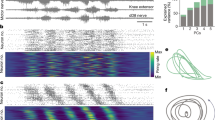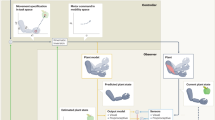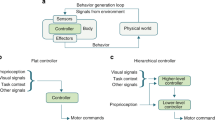Abstract
We used a computational analysis to identify the basic elements with which the vertebrate spinal cord constructs one complex behavior. This analysis extracted a small set of muscle synergies from the range of muscle activations generated by cutaneous stimulation of the frog hindlimb. The flexible combination of these synergies was able to account for the large number of different motor patterns produced by different animals. These results therefore demonstrate one strategy used by the vertebrate nervous system to produce movement in a computationally simple manner.
This is a preview of subscription content, access via your institution
Access options
Subscribe to this journal
Receive 12 print issues and online access
$209.00 per year
only $17.42 per issue
Buy this article
- Purchase on Springer Link
- Instant access to full article PDF
Prices may be subject to local taxes which are calculated during checkout




Similar content being viewed by others
References
Bernstein, N. The Coordination and Regulation of Movements (Pergamon Press, New York, 1967).
Lee, W. A. Neuromotor synergies as a basis for coordinated intentional action. J. Motor Behav. 16, 135–170 (1984).
Macpherson, J. M. in Motor Control: Concepts and Issues (eds. Humphrey, D. R. & Freund, H.–J) 33–47 (Wiley, Chichester, 1991).
Sherrington, C. S. Flexion–reflex of the limb, crossed extension–reflex and reflex stepping and standing. J. Physiol. (Lond.) 40, 28–121 (1910).
Grillner, S. in Handbook of Physiology, sec. 1, vol. 2 (ed. Brooks, V. B.) 1179 –1236 (American Physiological Society, Bethesda, MD, 1981).
Stein, P. S. G. & Smith J. L. in Neurons, Networks, and Motor Behavior (eds. Stein P. S. G., Grillner, S., Selverston A. I. & Stuart D. G.) 61–73 (MIT Press, Cambridge, MA, 1997).
Jacobs, R. & Macpherson, J. M. Two functional muscle groupings during postural equilibrium tasks in standing cats. J. Neurophysiol. 76, 2402–2411 ( 1996).
Bizzi, E., Mussa–Ivaldi, F A. & Giszter S. F. Computations underlying the production of movement: a biological perspective. Science 253, 287–291 (1991).
Giszter, S. F., Mussa–Ivaldi, F. A. & Bizzi, E. Convergent force fields organized in the frog spinal cord. J. Neurosci. 13, 467– 491 (1993).
Mussa–Ivaldi, F. A., Giszter, S. F., & Bizzi, E. Linear combinations of primitives in vertebrate motor control. Proc. Natl. Acad. Sci. USA 91, 7534–7538 (1994).
Bishop, C. M. Neural Networks for Pattern Recognition (Oxford Univ. Press, Oxford, 1995).
Hertz, J., Krogh, A. & Palmer R. G. Introduction to the Theory of Neural Computation (Addison–Wesley, Reading, MA 1991).
d'Avella, A. & Bizzi, E. Low dimensionality of supraspinally induced force fields. Proc. Natl. Acad. Sci. USA 95, 7711–7714 (1998).
Fleshman, J. W., Lev–Tov, A. & Burke, R. E. Peripheral and central control of flexor digitorum longus and flexor hallucis longus motoneurons: the synaptic basis of functional diversity. Exp. Brain Res. 54, 133– 149 (1984).
Pratt, C. A., Chanaud, C. M. & Loeb, G. E. Functionally complex muscles of the cat hindlimb. IV. Intramuscular distribution of movement command signals and cutaneous reflexes in broad, bifunctional thigh muscles. Exp. Brain Res. 85, 281–299 (1991).
Schouenborg, J. & Kalliomaki, J. Functional organization of the nociceptive withdrawal reflexes I. Activation of hindlimb muscles in the rat. Exp. Brain Res. 83, 67–78 (1990).
Schouenborg, J. & Weng, H.–R. Sensorimotor transformations in a spinal motor system. Exp. Brain Res. 100, 170–174 (1994).
Schouenborg, J., Weng, H.–R. & Holmberg, H. Modular organization of spinal nociceptive reflexes: a new hypothesis. News Physiol. Sci. 9, 261–265 (1994).
Berkinblitt, M. B., Feldman, A. G. & Fukson, O. I. Adaptability of innate motor patterns and motor control mechanisms. Behav. Brain Sci. 9, 585– 638 (1986).
Lawson, C. L. & Hanson, R. J. Solving Least Squares Problems. (Prentice–Hall, Englewood Cliffs, NJ, 1974).
Harman, H. H. Modern Factor Analysis (Univ. of Chicago Press, Chicago, 1976).
Olshausen, B. A. & Field, D. J. Emergence of simple–cell receptive field properties by learning a sparse code for natural images. Nature 381, 607– 609 (1996).
Acknowledgements
We thank Sandro Mussa–Ivaldi and Andrea d'Avella for reading versions of this manuscript and Simon Giszter, Peter Dayan, Kuno Wyler and James Galagan for suggestions. M.C.T. was supported by a HHMI predoctoral fellowship. This research was supported by NIH NS09343 and ONR N00014–95–I0445 to E.B.
Author information
Authors and Affiliations
Corresponding author
Rights and permissions
About this article
Cite this article
Tresch, M., Saltiel, P. & Bizzi, E. The construction of movement by the spinal cord. Nat Neurosci 2, 162–167 (1999). https://doi.org/10.1038/5721
Received:
Accepted:
Issue Date:
DOI: https://doi.org/10.1038/5721
This article is cited by
-
Developing new intermuscular coordination patterns through an electromyographic signal-guided training in the upper extremity
Journal of NeuroEngineering and Rehabilitation (2023)
-
Epidural stimulation restores muscle synergies by modulating neural drives in participants with sensorimotor complete spinal cord injuries
Journal of NeuroEngineering and Rehabilitation (2023)
-
Muscle synergy patterns as altered coordination strategies in individuals with chronic low back pain: a cross-sectional study
Journal of NeuroEngineering and Rehabilitation (2023)
-
Neurotechnologies to restore hand functions
Nature Reviews Bioengineering (2023)
-
Muscle coordination and recruitment during squat assistance using a robotic ankle–foot exoskeleton
Scientific Reports (2023)



